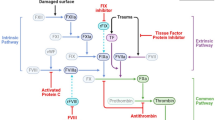Abstract
Hemoglobin E-beta thalassemia (Hb E/β-thalassemia) is a distinct, yet common, type of β-thalassemia, in which the patient co-inherits a β-thalassemia allele from one parent, and a structural variant, Hb E, from the other parent. This co-inheritance leads to remarkable clinical heterogeneity, varying degrees of chronic anemia, and a wide spectrum of complications due to ineffective erythropoiesis and iron overload. Hydroxyurea (HU), an oral chemotherapeutic drug, is expected to decrease disease severity. To assess the clinical efficacy and safety of HU in Hb E/β-thalassemia patients. We searched MEDLINE, EMBASE, Cochrane databases, and major preceding conferences for studies that assessed HU in Hb E/β-thalassemias patients. The effect size was estimated as a proportion (responder/sample size). Qualities of eligible studies were assessed using NIH tools. A total of five [one randomized clinical trial (RCT) and four observational] studies involving 106 patients were included. HU was associated with a significant RR of 46% with no statistical heterogeneity. No serious adverse effects were reported. Patients with Hb E/β-thalassemia may benefit from a trial of HU, though large RCTs assessing efficacy should be conducted to confirm the findings of this meta-analysis and to assess long-term toxicity and response sustainability.



Similar content being viewed by others
References
Weatherall DJ. The inherited diseases of hemoglobin are an emerging global health burden. Blood. 2010;115(22):4331–6.
Olivieri NF, Pakbaz Z, Vichinsky E. Hb E/beta-thalassaemia: a common and clinically diverse disorder. Indian J Med Res. 2011;134(4):522.
Vichinsky EP. Changing patterns of thalassemia worldwide. Ann N Y Acad Sci. 2005;1054(1):18–24.
Vichinsky E. Hemoglobin E syndromes. Hematology Am Soc Hematol Educ Program. 2007;2007:79–83. doi:10.1182/asheducation-2007.1.79.
Sripichai O, Makarasara W, Munkongdee T, Kumkhaek C, Nuchprayoon I, Chuansumrit A, et al. A scoring system for the classification of β-thalassemia/Hb E disease severity. Am J Hematol. 2008;83(6):482–4.
Weatherall DJ, Clegg JB. Historical perspectives: the many and diverse routes to our current understanding of the thalassaemias. The Thalassaemia Syndromes, 4th edn; 2001. p. 1–62.
Delea TE, Edelsberg J, Sofrygin O, Thomas SK, Baladi JF, Phatak PD, et al. Consequences and costs of noncompliance with iron chelation therapy in patients with transfusion-dependent thalassemia: a literature review. Transfusion. 2007;47(10):1919–29.
Musallam KM, Taher AT, Cappellini MD, Sankaran VG. Clinical experience with fetal hemoglobin induction therapy in patients with beta-thalassemia. Blood. 2013;121(12):2199–212.
Stroup DF, Berlin JA, Morton SC, Olkin I, Williamson GD, Rennie D, et al. Meta-analysis of observational studies in epidemiology: a proposal for reporting. JAMA. 2000;283(15):2008–12.
Moher D, Liberati A, Tetzlaff J, Altman DG. Preferred reporting items for systematic reviews and meta-analyses: the PRISMA statement. Ann Intern Med. 2009;151(4):264–9.
NIH. Study quality assessment tools. Available at: http://www.nhlbi.nih.gov/health-pro/guidelines/in-develop/cardiovascular-risk-reduction/tools. Accessed 10 Mar 2015.
Nyaga VN, Arbyn M, Aerts M. Metaprop: a Stata command to perform meta-analysis of binomial data. Arch Public Health. 2014;72(1):39.
DerSimonian R, Laird N. Meta-analysis in clinical trials. Control Clin Trials. 1986;7(3):177–88.
Higgins JP, Thompson SG, Deeks JJ, Altman DG. Measuring inconsistency in meta-analyses. BMJ Br Med J. 2003;327(7414):557.
Egger M, Smith GD, Schneider M, Minder C. Bias in meta-analysis detected by a simple, graphical test. BMJ. 1997;315(7109):629–34.
Begg CB, Mazumdar M. Operating characteristics of a rank correlation test for publication bias. Biometrics. 1994;50(4):1088–101.
StataCorp. 2013. Stata Statistical Software: Release 13. College Station TSL. StataCorp. 2013. Stata Statistical Software: Release 13. College Station: StataCorp LP.
Bohara VV, Ray S, Chakrabarti P, Ray SS, Nath UK, Chaudhuri U. Optimizing the dose of hydroxyurea therapy for patients with beta-thalassemia intermedia (Hb E-beta-thalassemia): a single center study from Eastern India. Hemoglobin. 2014;38(1):44–8.
Italia K, Jijina F, Merchant R, Swaminathan S, Nadkarni A, Gupta M, et al. Comparison of in vitro and in vivo response to fetal hemoglobin production and -mRNA expression by hydroxyurea in hemoglobinopathies. Indian J Hum Genet. 2013;19(2):251–8.
Italia KY, Jijina FF, Merchant R, Panjwani S, Nadkarni AH, Sawant PM, et al. Effect of hydroxyurea on the transfusion requirements in patients with severe HbE-beta-thalassaemia: a genotypic and phenotypic study. J Clin Pathol. 2010;63(2):147–50.
Singer ST, Kuypers FA, Olivieri NF, Weatherall DJ, Mignacca R, Coates TD, Vichinsky EP. Fetal haemoglobin augmentation in E/β0 thalassaemia: clinical and haematological outcome. Br J Haematol. 2005;131(3):378–88.
Fucharoen S, Siritanaratkul N, Winichagoon P, Chowthaworn J, Siriboon W, Muangsup W, et al. Hydroxyurea increases hemoglobin F levels and improves the effectiveness of erythropoiesis in beta-thalassemia hemoglobin E disease. Blood. 1996;87(3):887–92.
Algiraigri AH, Wright NA, Kassam A. Hydroxyurea for β-thalassemia major: a meta-analysis. Blood. 2014;124(21):4894.
Algiraigri AH, Radwi M. Long-term safety of hydroxyurea in sickle cell anemia and other benign diseases: systematic review and meta-analysis. Blood. 2014;124(21):560.
Moore RD, Charache S, Terrin ML, Barton FB, Ballas SK. Cost-effectiveness of hydroxyurea in sickle cell anemia. Investigators of the multicenter study of hydroxyurea in sickle cell anemia. Am J Hematol. 2000;64(1):26–31.
Kavanagh BD, Fischer IBA, Segreti EM, Wheelock JB, Boardman C, Roseff SD, et al. Cost analysis of erythropoietin versus blood transfusions for cervical cancer patients receiving chemoradiotherapy. Int J Radiat Oncol Biol Phys. 2001;51(2):435–41.
Delea TE, Sofrygin O, Thomas SK, Baladi J-F, Phatak PD, Coates TD. Cost effectiveness of once-daily oral chelation therapy with deferasirox versus infusional deferoxamine in transfusion-dependent thalassaemia patients. Pharmacoeconomics. 2007;25(4):329–42.
Algiraigri AH, Wright NA, Paolucci EO, Kassam A. Hydroxyurea for nontransfusion-dependent β-thalassemia: a systematic review and meta-analysis. Hematol Oncol Stem Cell Ther. 2017. doi:10.1016/j.hemonc.2017.02.002.
Acknowledgements
The authors thank the authors of the studies included in our meta-analysis for providing additional information about their studies at our request.
Author information
Authors and Affiliations
Contributions
AA envisioned and designed the study, and wrote the manuscript; AK edited the protocol wrote the protocol, searched the literature, extracted the data, evaluated the quality of eligible studies, analyzed and interpreted the data, extracted the data, evaluated the quality of eligible studies, analyzed and interpreted the data and edited the manuscript.
Corresponding author
Ethics declarations
Conflict of interest
All authors state that they do not have any conflicts of interest to declare.
About this article
Cite this article
Algiraigri, A.H., Kassam, A. Hydroxyurea for hemoglobin E/β-thalassemia: a systematic review and meta-analysis. Int J Hematol 106, 748–756 (2017). https://doi.org/10.1007/s12185-017-2307-0
Received:
Revised:
Accepted:
Published:
Issue Date:
DOI: https://doi.org/10.1007/s12185-017-2307-0




